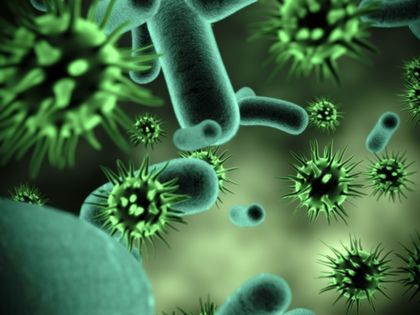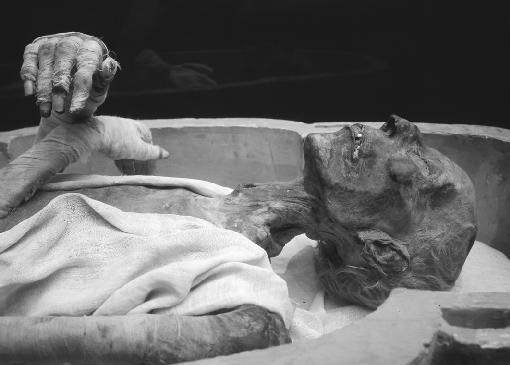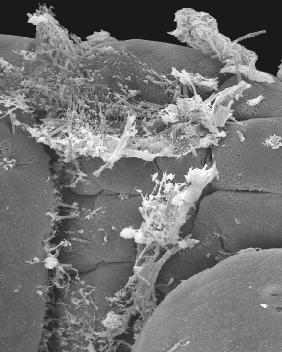Chapter 1
We Are Surrounded

We are not alone. No matter how clean we are or how healthy we feel, we carry around on our bodies billions of microbes—microscopic one-celled organisms called bacteria and viruses. Although they cannot be seen, microbes hide under fingernails, lurk between teeth, and live in hair. There are more than six hundred thousand bacteria living on just one square inch of skin, and an average person has about a quarter of a pound of bacteria in and on his or her body at any given time. There are more microbes on a person's body than there are humans on Earth.
Viruses and bacteria are responsible for some of the deadliest diseases in history, such as AIDS, the plague, and flu. And yet bacteria perform the most important roles in maintaining life on this planet. "They [bacteria] protect us and feed us," says Abigail Salyers, former president of the American Society for Microbiology. "All life on Earth depends on their activities." 1 Bacteria are the planet's recyclers, plant nurturers, and undertakers.
Microbes have been found in almost every type of environment. Some thrive in subzero Arctic ice, while others live in boiling undersea volcanoes. Bacteria have been found inside oil-drilling cores pulled from more than a thousand feet down in the earth's crust, and it has been estimated that there may be as much as 100 trillion tons of bacteria deep beneath the surface of the earth. If all the subterranean microbes were brought to the surface, they would cover the planet with a layer five feet deep. Microbes have been discovered six miles beneath the Pacific Ocean, where the pressure is equivalent to being squashed by fifty jumbo jets, as well as nineteen miles out in space.
Professor Adrian Gibbs of the Australian National University asserts, "You can increase the probability of finding new things by looking in interesting places, like deep sea vents or thermal pools, but you can also find them in your own backyard." 2 One teaspoon of ordinary soil contains 10 million bacteria, and one acre of soil can hold up to five hundred pounds of microscopic life. There is more unseen life than seen. The mass of all microbes on the planet is twenty-five times more than the mass of all other animals combined. The human race may believe it is at the top of the food chain, but microbes are the food chain.

Ancient Microbes
How did these organisms become so widespread? The answer lies in the fossil record. Scientist J. William Schopf found evidence of ancient microbes in rock samples collected in western Australia in the 1980s. These rocks proved that bacteria had been on Earth for more than 3.5 billion years, long enough to adapt to nearly every type of environment. In his book Cradle of Life , Schopf notes, "These organisms are not only extremely ancient but surprisingly advanced, and show that early evolution proceeded faster and faster than anyone imagined." 3 Scientists have even discovered a strain of bacteria that can survive blasts of radiation one thousand times greater than the amount needed to kill a human being.

Scientists have not found fossil evidence of ancient viruses and may never do so because viruses are so small. But researchers believe that viruses have been around just as long as bacteria have, or even longer. Deadly viruses may have played a part in the extinction of the dinosaurs and are thought to have contributed to human evolution.
Historians do know that bacteria and viruses infected human civilizations as far back as three thousand years ago. The mummy of Egyptian pharaoh Ramses V has the telltale signs of scars caused by the deadly smallpox virus. The shriveled arms and legs of other mummies suggest that these people suffered from the polio virus. And the Bible describes an ancient plague, reminiscent of anthrax, which caused "sores that break into pustules on man and beast." 4
Bacteria
One reason scientists believe that microbes have survived for so long is their simple structure. A bacterium is a primitive one-celled organism. Like all living things, it grows, uses energy, makes waste, and reproduces all within one cell. A hard cell wall made of cellulose provides support and protects the bacteria from antibiotic substances, such as medicines, tears, and saliva. An inner lining, called the cell membrane, acts as the gatekeeper controlling what goes in and out. Some bacteria also have a sticky outer coat, called a capsule, that allows the bacteria to stick to other cells.
Bacteria come in three basic shapes: Cocci (pronounced cox-eye) are shaped like little round balls; bacilli (buh-sill-eye) are rod- or stick-shaped; and spi rilla (spy-rill-uh) form a spiral. Scientists estimate that there may be a million species of bacteria in the world and more than five thousand different viruses, but only a small fraction of these has ever been studied.
Some bacteria exist as individual cells floating on their own, while others cluster together to form pairs that scientists call diplo. Several bacteria strung together in a chain are called strepto, and when bacteria stick together in clusters, they are referred to as staphylo.
Bacteria have a wide-ranging diet. Some bacteria are capable of photosynthesis, just like plants. They make their own food from sunlight and give off oxygen. These bacteria are called cyanobacteria. Although these aquatic organisms are often referred to as blue-green algae, that name is misleading because they are not related to other types of algae.
Other bacteria absorb nutrients from the materials that surround them. There are bacteria that feed off of wood, glue, paint, and anything dripped, dribbled, or left out on the kitchen counter too long. Others eat iron, sulfur, petroleum, a variety of toxic chemicals, and even radioactive plutonium. The bacteria that live in a person's stomach absorb the nutrients from ingested food. A rotten spot on an apple is evidence that bacteria are eating. The sour smell of old milk is a clue that bacteria are there. And the feeling of fuzzy teeth in the morning is evidence that bacteria are at work.
Although most bacteria cannot move about their environment on their own, some have flagella, long whiplike tails that propel bacteria through a drop of liquid. One bacterium's flagellum was recorded moving twenty-four hundred beats per minute. Other bacteria are not as speedy. They secrete a slime that allows them to slide over surfaces like a slug, or they move with the help of cilia, tiny hairlike structures that beat wildly.
Bacteria move in response to their environment. While studying Escherichia coli (the bacteria that live in human intestines and can sometimes cause diarrhea), researchers identified special structures called nose spots. These nose spots allow the bacterium to sense the presence of food and move toward it. They also detect toxins and move away from them. These nose spots are extremely sensitive and can perceive tiny changes in the surrounding environment. It is the same degree of sensitivity that would allow a person to detect the difference between a jar with 9,999 pennies and one with 10,000 pennies. When food is detected, the receptors send a message to the flagella, which then beat rhythmically, carrying the bacteria toward the increased concentration of food.
When food is not available, bacteria are capable of lying dormant for many years in the form of a spore. Spores of anthrax have been found in eighty-year-old museum displays; other bacterial spores have been brought back to an active state from cans of meat that were 118 years old and beer that was 166 years old. Russian scientists even claim to have brought back to life bacteria that was frozen in Arctic ice for a million years.
Spores are hard to find because they are microscopic. All bacteria are measured in nanometers. One nanometer is one-billionth of a meter. The period at the end of this sentence is about 1 million nanometers in diameter. The average bacterium, in comparison, is only one thousand nanometers across.
Bacteria are small, but viruses are even smaller. To get an idea of their size, imagine one human cell the size of a baseball diamond. In that cell, an average bacterium would be the size of the pitcher's mound. But a single virus would be the size of a baseball. Scientists need to use a powerful piece of equipment called an electron microscope to enter the world of the virus.
Viruses
Bacteria and viruses are often grouped together under the heading of microbes, but there are vast differences between them, and size is just one of those differences. While bacteria perform all of the functions necessary to be considered a life form, scientists debate whether viruses are alive at all. For something to be alive it must eat, grow, make waste, and reproduce. When a virus is floating around in the air or sitting undisturbed in soil, it is no more alive than a rock. But if that same virus comes in contact with a suitable animal, plant, or bacterium cell, it suddenly becomes active. A virus does not eat, but it gets its energy from the host cell it infects. It does not grow in the sense that it gets larger, but it does reproduce. In fact, a virus's sole purpose seems to be reproduction, and it cannot do that without the help of a living cell.
A virus is not even considered a true cell. It is simply a tiny bundle of genetic material, DNA (deoxyribonucleic acid) or RNA (ribonucleic acid), surrounded by a protein coat. Both DNA and RNA are the molecules that contain coded genetic information. They make up genes that determine what an organism looks like and how it behaves. Unlike the DNA in an animal or plant cell that is contained in a nucleus, viral DNA floats loosely within the protein coat, or capsid.
Like bacteria, viruses come in many shapes and sizes. Many are multisided and look like a cut diamond. Other viruses are shaped like sticks, ovals with spikes, or tiny sausages. The deadly Ebola virus looks like a piece of looped string. Viruses that attack bacteria are called bacteriophages and resemble tiny lunar landing modules or alien spaceships.
Microbial Multiplication
Microbes are experts at mass production. Bacteria reproduce through a process called binary fission. One cell divides into two cells, each of which then divide into two more. Each cell is identical to the mother cell. Most bacteria divide every two or three hours, some wait as long as sixteen hours, and others are capable of dividing every fifteen minutes. One researcher estimated that if one bacterium reproduced every twenty minutes without running out of food or encountering any toxins, it would grow into a colony of 2 million bacteria within seven hours.
Viruses are just as productive, but they cannot do it alone. Viruses need the reproductive mechanisms of a living cell in order to multiply, but first the virus must get inside the cell. A cell's membrane is made out of protein molecules, and some molecules have specially shaped receptors, or landing sites, where other molecules with matching shapes can land and dock. This lock-and-key system allows the entry of only certain molecules that are necessary for normal cell function. For example, essential nutrients such as oxygen are allowed to pass through the membrane to one of many of the cell's powerhouses, the mitochondria. Nitrogen is received at different sites on the membrane and shuttled through to be used in the assembly of various proteins.
But viruses have also acquired the key to specific cells. For example, the pneumonia virus is capable of latching on to a human lung cell. The virus that causes hepatitis can infect human liver cells. The human immunodeficiency virus (HIV) that causes AIDS is capable of landing on white blood cells.
Once a virus attaches to a host cell, it inserts its genetic material in one of three ways. Some host cells are fooled into thinking that the virus is food. These cells pull the genetic material in just as they would pull in other nutrients. Other viruses have a sticky coat that fuses with the cell's membrane, and the genetic material enters that way. Other viruses forcibly pierce the cell's membrane and inject their DNA into the host.
The genetic material from the virus hijacks the reproductive machinery of the host cell and provides it with a new set of instructions to follow. The cell is now programmed to make hundreds of copies of the virus's DNA or RNA instead of its own.
The virus then uses the cell's enzymes, which are molecules that control chemical changes, to build new capsids and other proteins it needs to survive. Like a genetic factory, the host cell churns out viral parts that are assembled into brand-new identical viruses. All other cell functions are shut down to conserve energy for producing as many viruses as the cell can stand. Some cells simply fall apart from exhaustion, and viruses tumble free. But other viruses actively dissolve the cell membrane to get out. Stronger cells will fill up with viruses until they burst like an overfilled water balloon. The new viruses are free to infect other host cells, a process that spreads the disease. This continues until the virus is stopped or the host dies.
Microbes at Work
Other microbes can cause the death of their hosts too, but the vast majority of bacteria play a vital role in Earth's ecosystem. All life on Earth is connected in a web of relationships. Every creature, no matter how small, has a job to do, and microbes are the workhorses of the living world.
Bacteria keep the planet's life cycles turning. It is an important job because the earth is a closed system. There is only a limited amount of the materials that sustain all living things, and these elements—oxygen, carbon, hydrogen, nitrogen, phosphorus, and so on—have to be recycled again and again. Microbes are the key players, chemists building, breaking down, and rebuilding chemical compounds for both animal and plant use. For example, animals breathe in oxygen and exhale carbon dioxide (CO 2 ). Plants take in that CO 2 and release oxygen that will be taken up again by animals. Microbes beneath the sea pump out about 150 billion kilograms of oxygen every year, producing onehalf of all the oxygen we breathe. This recycling process seems simplistic on the surface, but scientists are awed by the complexity of this assembly-line efficiency that is required to keep the earth's ecosystem cycling. If that system were to stop, all the oxygen in the air would be exhausted within twenty years.
A similarly complex cycle occurs for nitrogen. Nitrogen exists in every living cell and is necessary for building proteins. Although nitrogen is the most common gas in the atmosphere, animals cannot use it in that form. Animals get their nitrogen from eating plants or eating plant eaters. Most plants are also unable to take nitrogen from the air; they get their cellbuilding nitrogen from the soil. But most plants cannot get the nitrogen they need without the help of nitrogen-fixing bacteria. These bacteria "fix" the nitrogen by combining the nitrogen in the atmosphere with other elements to form organic compounds in living cells. When these cells later die, the nitrogen, now in a fixed form, is readily available to the plants through their root systems with the help of other bacteria in the soil. In return, the plant supplies the microbes with nutrients for their growth. Some bacteria simply live in the soil surrounding the roots, but other kinds of bacteria actually live inside the roots of plants.
Farmers rejuvenate their fields by planting nitrogenfixing crops such as the pea plant. These plants have a powerful partnership with a bacterium called Rhizobium. As a young pea plant sends out its roots, it also sends out a signal to willing bacteria. The bacteria in the soil migrate to the roots, where they are surrounded by and eventually become part of the roots. An uprooted pea or clover plant reveals tiny nodules or bumps where the bacteria are working to fix nitrogen for the plant. In return, the plant provides the bacteria with a safe home and the nutrients they need to live. This system is very effective. Researchers estimate that the bacteria living in Asian rice paddies are capable of fixing more than six hundred pounds of nitrogen per acre.
Decomposition
Another job of the microbial chemists is to free up the essential chemical compounds that are trapped in plants and animals and would otherwise remain trapped after death. Bacteria (along with fungi) are the undertakers of the microbial world. Bacteria help break down the dead matter in a process called decomposition. If all the microbes were wiped out suddenly, nothing would rot. We would eventually be knee-deep in dead organisms.
All living things only borrow their atoms. They must be continually rotated and returned to the soil so that other plants and animals can grow. The fertilizers that people put on their lawns are nothing more than mixtures of chemical compounds of phosphorus, nitrogen, sulfur, and potassium, the same elements that are released into the soil by the decomposing activities of microbes.
The Bacterial Buddy System
Just as some bacteria form partnerships with plants, other bacteria form partnerships with animals. One of the most common relationships involves bacteria digesting other animals' food.
Ruminant animals like cattle, sheep, goats, giraffes, and camels are incapable of digesting cellulose, a tough, protective structural substance that forms plant cell walls. Yet leafy greens are their prime food source. The only creatures known to digest cellulose are microbes, so the only way ruminant animals can get any nutrition from plants is to harbor a healthy amount of bacteria in two of their four stomachs. The first two stomachs in the digestive system of a cow contain billions of bacteria that break down the cellulose into glucose, which the cow's cells can use.
Humans rely on bacteria to digest the cellulose in food too. When babies are born, their mouths and digestive tracts are sterile; there are no microbes living there yet. Newborns have been protected from all infection, including beneficial microbes, by the placenta. But the first time babies are fed, they get the bacteria they need to digest food for the rest of their lives.

Besides breaking down tough cellulose in a person's diet, the bacteria that live in the large intestine also produce essential vitamins (K, B 12 , thiamine, and riboflavin) that humans could not make themselves. Studies of animals born and raised in a sterile environment show how vital microbes are to survival. Without them a person would have a whole host of problems. Without vitamin K, which is necessary in the clotting process of blood, a person would be prone to uncontrolled bleeding. Without vitamin B 12 , a person would suffer from a blood disorder called pernicious anemia. Scientists did not realize the importance of bacteria in our digestive system until the development of antibiotics. They were surprised to find that people developed digestive problems when taking an antibiotic. The drug killed the "good" bacteria in the intestines as well as the "bad" bacteria that made them sick.
Viruses and Evolution
Microbiologists are discovering new information every day about the important roles bacteria play in the world's ecosystem. But no one has yet discovered if viruses have a beneficial function. Recent studies suggest that viruses may play some part in the adaptations that change species over time. Geneticists have found bits and pieces of viral DNA inside animal cells. These small fragments were probably left behind from a time when that animal was infected with the virus. While the host cells were reproducing the virus's DNA parts, the genetic material was pulled into the host's genes. There they survived in the host's cells and were passed down to the animal's offspring.
Geneticists discovered that this "junk" DNA accounts for nearly half of a person's genetic material, or genome. "People started to seriously consider that they [viruses] might contribute to evolution," 5 says John McDonald, a molecular evolutionist at the University of Georgia. Certain viral genes may have caused significant changes in human looks and behavior or even the branching off of man from ape 6 million years ago.
Bacteria and viruses have inhabited the earth much longer than humans have and were performing important tasks long before we arrived. Microbiologists are still learning the intricate connections that link the microbe's existence with our own. The smallest organisms on Earth have had a powerful effect. They have even altered the course of human history.
thanks,
Jacc
How much of our body weight is not us?
thank you again
It is always found on the outside of a cytoplasmic membrane (composed of phospholipids). Some bacteria sport an extra exterior membrane with a modified composition with respect to the inner cytoplasmic membrane. In this case the peptidoglycan layer is thin and is sandwiched between two membranes.